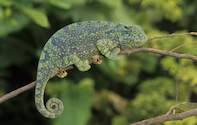
Chameleon species are not numerous compared to many other groups of reptiles. Southern Africa has 14 species of endemic dwarf chameleons presently recognised, mostly from the Cape and KwaZulu-Natal. We have one in our area, recorded from the escarpment forests. There are two species of leaf chameleons in eastern Zimbabwe and central Mozambique.
Of around 45 species of common chameleon'- (genus Chamaeleo) - two are found in southern Africa. One (the Namaqua chameleon)is confined to the dry, western areas.
The other - the flap-neck chameleon (Chamaeleo dilepis) - occurs from the Kalahari eastwards but north of the Cape province and down the KZN coastal area. This latter species is the one you are most likely to encounter in the lowveld.
Due to their slow movement and ability to change colour to match the background, these fascinating creatures are often overlooked.They are most easily spotted during night drives with the use of a search light when they appear almost luminous in their lighter, sleeping colour.
Although not considered endangered, chameleons are a highly threatened group - particularly the flap-neck chameleon which inhabits populated and agricultural areas.
They have many natural predators which include arboreal snakes, larger shrikes and certain raptors. Like most birds and reptiles, there is only about a two percent probability of survival to adult breeding age. The chances of successful breeding are even less.
The greatest threat to their survival comes from human activities. Destruction of habitat for development and chemical control of their (insect) food species severely restricts their range.
Traditional, cultural 'taboo' results in unjustified persecution. Veld fires are probably the greatest killer, from which they have no escape. Their natural instinct is to climb up from danger, which takes them into the hottest part of flames. There is very likely 100 percent destruction of chameleons in a hot burn.

Being slow movers they are, like many other creatures, very vulnerable when crossing roads. They and other reptiles are often intentionally run over.
People don't seem to realise or care that they are destroying valuable allies. I was moved by a recent photo showing a poor leguaan with all her eggs squashed out on one of the Kruger Park roads.
It obviously occurred during daylight and must have been intentional. What a very sad incident. I am illustrating a similar occurrence with a female chameleon - at the very peak of her effort to maintain her 'tribe'.
It is very sad that we, the so-called, most highly developed form of life, are so destructive through carelessness or lack of regard for other life forms. It is easy to make a mistake and incidents are often unavoidable but if everyone was more environmentally aware and less self-seeking the earth would be in a better state. We are destroying the very foundations of our own survival. Think before you illegally burn or otherwise destroy our veld and keep your eyes on the road for those creatures that are finding it hard enough to keep functioning without you running them over. Your turn will be next !

 African reptiles guide to the reptile species found in Kruger National Park. This Africa Reptiles guide includes information and photographs...
African reptiles guide to the reptile species found in Kruger National Park. This Africa Reptiles guide includes information and photographs...